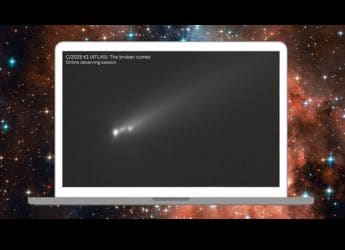- Home
- Science
- Science News
- James Webb Telescope May Have Discovered Universe’s Earliest Supermassive Black Hole
James Webb Telescope May Have Discovered Universe’s Earliest Supermassive Black Hole
The find demonstrates JWST's ability to expand the horizons of our knowledge of the universe.

Photo Credit: NASA / ESA / CSA / T. Treu, UCLA / NAOJ / T. Bakx, Nagoya U.
Galaxy GHZ2 may host the universe’s earliest and most distant supermassive black hole
NASA's James Webb Space Telescope may have found the most distant and earliest supermassive black hole (203 million years after the Big Bang) identified to date at its time of observation, in the centre of galaxy GHZ2. Appearing as it was a mere 350 million years after the Big Bang, this black hole is one of these rare sizes, the researchers said on Wednesday at an AAS press conference.
With JWST's Near Infrared Spectrograph (NIRSpec) and Mid-Infrared Instrument (MIRI), astronomers observed the galaxy's ultraviolet and optical light redshifted into infrared wavelengths because of the expansion of space — but they did find unusually high-energy emission lines from a black hole actively feeding.
Early Universe Surprise: James Webb Detects Signs of Active Supermassive Black Hole in GHZ2
According to a report on the preprint server arXiv, the team led by Oscar Chavez Ortiz noted that the high-ionisation C IV λ1548 emission line strongly suggests the presence of an active galactic nucleus. “Detecting such a system at this early epoch raises questions about how supermassive black holes gain mass so quickly,” Chavez Ortiz explained, emphasising that the findings challenge current models of black hole growth and galaxy coevolution.
Co-author Jorge Zavala noted that strong carbon emission indicates AGN presence, suggesting mixed star formation and black hole activity, testing early universe formation models.
JWST and ALMA May Confirm Universe's Most Distant Supermassive Black Hole, Revealing Early Cosmic Growth
JWST and ALMA observations are targeted to establish AGN activity in GHZ2, possibly the most distant supermassive black hole ever observed, tracing out early cosmic growth.
The find demonstrates JWST's ability to expand the horizons of our knowledge of the universe, revealing ancient galaxies and how quickly these behemoths formed their massive black holes.
Get your daily dose of tech news, reviews, and insights, in under 80 characters on Gadgets 360 Turbo. Connect with fellow tech lovers on our Forum. Follow us on X, Facebook, WhatsApp, Threads and Google News for instant updates. Catch all the action on our YouTube channel.
Related Stories
- Samsung Galaxy Unpacked 2025
- ChatGPT
- Redmi Note 14 Pro+
- iPhone 16
- Apple Vision Pro
- Oneplus 12
- OnePlus Nord CE 3 Lite 5G
- iPhone 13
- Xiaomi 14 Pro
- Oppo Find N3
- Tecno Spark Go (2023)
- Realme V30
- Best Phones Under 25000
- Samsung Galaxy S24 Series
- Cryptocurrency
- iQoo 12
- Samsung Galaxy S24 Ultra
- Giottus
- Samsung Galaxy Z Flip 5
- Apple 'Scary Fast'
- Housefull 5
- GoPro Hero 12 Black Review
- Invincible Season 2
- JioGlass
- HD Ready TV
- Laptop Under 50000
- Smartwatch Under 10000
- Latest Mobile Phones
- Compare Phones
- Huawei Mate 80 RS Master Edition
- Huawei Mate 80 Pro Max
- Huawei Mate 80 Pro
- Huawei Mate 80
- Huawei Mate X7
- Honor 500
- Honor 500 Pro
- Lava Agni 4
- Asus ProArt P16
- MacBook Pro 14-inch (M5, 2025)
- Huawei MatePad Edge
- iQOO Pad 5e
- Huawei Watch Ultimate 2
- Huawei Watch GT 6 (41mm)
- Acerpure Nitro Z Series 100-inch QLED TV
- Samsung 43 Inch LED Ultra HD (4K) Smart TV (UA43UE81AFULXL)
- Asus ROG Ally
- Nintendo Switch Lite
- Haier 1.6 Ton 5 Star Inverter Split AC (HSU19G-MZAID5BN-INV)
- Haier 1.6 Ton 5 Star Inverter Split AC (HSU19G-MZAIM5BN-INV)

















